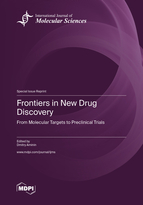Frontiers in New Drug Discovery: From Molecular Targets to Preclinical Trials
A special issue of International Journal of Molecular Sciences (ISSN 1422-0067). This special issue belongs to the section "Molecular Pharmacology".
Deadline for manuscript submissions: closed (31 August 2022) | Viewed by 22923
Special Issue Editor
Interests: biochemistry; cell biology; structure and function of biological membranes; mechanism of biological activity of natural and synthetic biologically active substances; new drug discovery; molecular targets; toxicology; ecotoxicology; biomarkers; biosensors
Special Issues, Collections and Topics in MDPI journals
Special Issue Information
Dear Colleagues,
This Special Issue will focus on new drug discovery aspects including the search for new molecular targets of various diseases, the creation of new modern methods for diagnosing diseases, the development of new test systems and kits for assessing the selectivity and effectiveness of new drugs, the study of the molecular mechanisms of biologically active compounds, the formulation of new drugs, and pharmacokinetic and pharmacodynamic studies. Preclinical trials of important molecules are also appreciated.
The main topics of interest are listed below:
- The discovery of new molecular targets including receptors, enzymes, ion channels, proteins, genes, etc.;
- The application of modern methods for drug discovery including SPR, optical molecular imaging, MRI, PET, SPECT, CT, ultrasound molecular imaging, MS imaging and multimodality imaging;
- New methods of developing sensitive and selective test systems and assays to detect drug interactions with specific molecular targets related to different diseases;
- Drug modulation of specific signaling pathways involved in disease genesis and progression;
- Pharmacokinetic and pharmacodynamic behavior of substances;
- Computer modeling of drug interaction with molecular targets, docking, molecular dynamics, QSAR, etc.;
- Drug delivery systems including targeted molecules, liposomes, nanoparticles, and cells as a carrier;
- Preclinical trials of important molecules on animal models of diseases including xenografts.
Dr. Dmitry Aminin
Guest Editor
Manuscript Submission Information
Manuscripts should be submitted online at www.mdpi.com by registering and logging in to this website. Once you are registered, click here to go to the submission form. Manuscripts can be submitted until the deadline. All submissions that pass pre-check are peer-reviewed. Accepted papers will be published continuously in the journal (as soon as accepted) and will be listed together on the special issue website. Research articles, review articles as well as short communications are invited. For planned papers, a title and short abstract (about 100 words) can be sent to the Editorial Office for announcement on this website.
Submitted manuscripts should not have been published previously, nor be under consideration for publication elsewhere (except conference proceedings papers). All manuscripts are thoroughly refereed through a single-blind peer-review process. A guide for authors and other relevant information for submission of manuscripts is available on the Instructions for Authors page. International Journal of Molecular Sciences is an international peer-reviewed open access semimonthly journal published by MDPI.
Please visit the Instructions for Authors page before submitting a manuscript. There is an Article Processing Charge (APC) for publication in this open access journal. For details about the APC please see here. Submitted papers should be well formatted and use good English. Authors may use MDPI's English editing service prior to publication or during author revisions.
Keywords
- new drug discovery
- molecular targets
- signaling pathways
- methods for diagnosing diseases
- test systems
- pharmacokinetics and pharmacodynamic
- computer modeling, drug delivery
- preclinical trials







